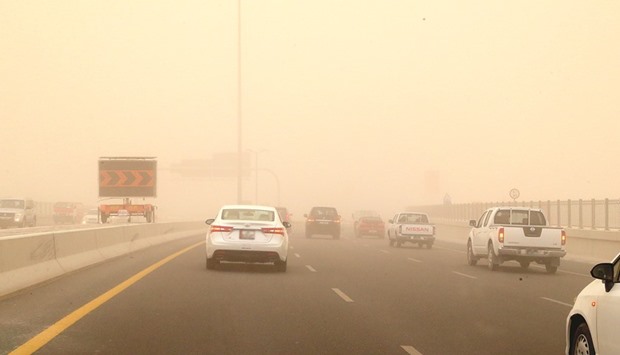We had a bit of excitement in Doha recently when a huge dust storm swept across the city. If you saw the sandstorm of August 24 arriving, I think you’ll agree that it was a rather daunting sight: a huge wall of dust which slowly swallowed the landscape. As the dust rolled across us, the weather changed in an instant; the winds picked up, the visibility plummeted and the temperature eased a fraction. My friend watched in disbelief as the wind picked up a bench in his garden and tossed it into his swimming pool.
A sandstorm that forms a distinctive wall of dust like this is called a haboob. The word is believed to have originated from Sudan and comes from the Arabic word for wind. They are not formed simply by a strong wind blowing across the land, but need the air to blast downwards, towards the ground, in order to kick up such a vast amount of dust.
The downwards blast of air necessary is usually supplied courtesy of a decaying thunderstorm. Any thunderstorm has plenty of air moving upwards and downwards within it. Air needs to be drawn upwards into the atmosphere in order for the storm cloud to form in the first place. The storm will then need a constant supply of air in order to survive. As the air rises, it cools and any moisture in it will condense into water droplets, providing the moisture necessary for the cloud and the rain.
Air also sinks from the cloud. After delivering the moisture, the cooler air will then head towards the Earth, often dragged downwards by the falling rain of the thunderstorm. This is why the temperature often drops and the wind picks up as the rain starts.
The strength of the up and down drafts can depend on many factors, such as the temperature of the ground, the temperature of the air, how much moisture is in the air, but it’s these vertical movements which largely determine the degree of severity of the storm.
On Wednesday, August 25, we didn’t see a thunderstorm in Doha, but there was one in the north of Qatar. North of Shanhaniya, a number of rumbles of thunder were heard and rain fell across the parched landscape. Although thunderstorms are more common in the north of Qatar than they are in Doha, it is still fairly unusual to see rain anywhere in the country in August.
As the storm crossed the Qatar peninsula, it started to decay. When a storm collapses, it blasts a lot of air towards the ground. As the air hits the ground, it spreads out in all directions. If the ground is very dry with a lot of loose particles lying around, the strong winds will pick up these particles and hurl them high into the atmosphere. This is what happened in Qatar, causing the leading edge of the air from the thunderstorm to appear as a huge wall of dust.
Surprisingly, haboobs aren’t that uncommon. They can hit anywhere where there are enough loose, dry particles lying around. This essentially means that any desert could be hit by a haboob. As well as Qatar and the Arabian Peninsula, haboobs have been spotted in western China, the southwestern USA, Australia, South Africa and Argentina.
The most intense haboobs can extend up to 10,000 feet into the atmosphere and can travel at speeds of up to 80 kilometres per hour (50 miles per hour). They have been known to travel for distances of more than 160 kilometres (100 miles) and in many countries they have been known to tear down trees and power lines. If you see one coming, you can expect the visibility to drop for anything from 10 minutes to a couple of hours.
Given their spectacular nature, they make impressive photos, but because they bring such a dramatic change in the weather, they can be very dangerous for drivers. Haboobs can creep up behind you and cause the visibility to drop to next-to-nothing in a matter of seconds.
If you are caught in a sudden dust storm, the National Weather Service in the US recommends that you pull off to the side of the road immediately and switch all your lights off. This is to avoid being hit from behind by another vehicle who may be trying to follow your taillights. However, on many of Doha’s roads this is impractical. Driving slowly, allowing plenty of room between you and the car in front, is always a good option in adverse weather.
We will probably have to wait a while to see another haboob, if only because thunderstorms are so uncommon at this time of year. In the last ten years, the earliest that a thunderstorm has brought rain to Doha was at the end of September. However, there is a change of the weather on the cards in Qatar.
On Tuesday the winds are forecast to turn northerly. This may bring some dust, but it will also bring an end to the humidity which has been so relentless this summer. Drier air would certainly be a welcome change, even if it’s only temporary.

ENVIRON


